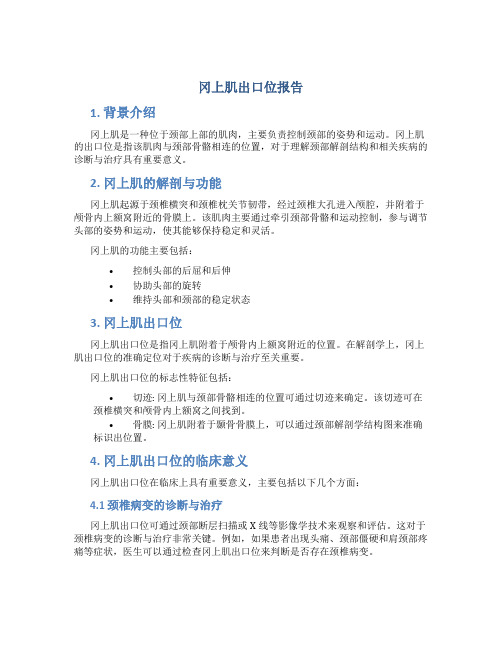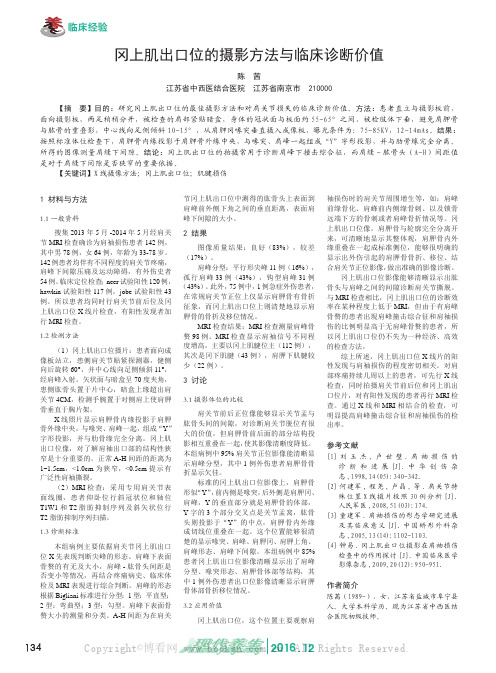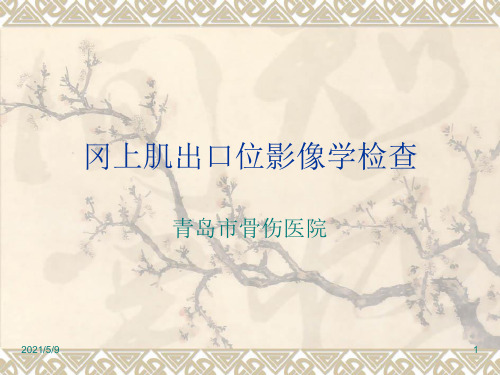冈上肌出口位
冈上肌出口位报告

冈上肌出口位报告1. 背景介绍冈上肌是一种位于颈部上部的肌肉,主要负责控制颈部的姿势和运动。
冈上肌的出口位是指该肌肉与颈部骨骼相连的位置,对于理解颈部解剖结构和相关疾病的诊断与治疗具有重要意义。
2. 冈上肌的解剖与功能冈上肌起源于颈椎横突和颈椎枕关节韧带,经过颈椎大孔进入颅腔,并附着于颅骨内上额窝附近的骨膜上。
该肌肉主要通过牵引颈部骨骼和运动控制,参与调节头部的姿势和运动,使其能够保持稳定和灵活。
冈上肌的功能主要包括:•控制头部的后屈和后伸•协助头部的旋转•维持头部和颈部的稳定状态3. 冈上肌出口位冈上肌出口位是指冈上肌附着于颅骨内上额窝附近的位置。
在解剖学上,冈上肌出口位的准确定位对于疾病的诊断与治疗至关重要。
冈上肌出口位的标志性特征包括:•切迹: 冈上肌与颈部骨骼相连的位置可通过切迹来确定。
该切迹可在颈椎横突和颅骨内上额窝之间找到。
•骨膜: 冈上肌附着于颞骨骨膜上,可以通过颈部解剖学结构图来准确标识出位置。
4. 冈上肌出口位的临床意义冈上肌出口位在临床上具有重要意义,主要包括以下几个方面:4.1 颈椎病变的诊断与治疗冈上肌出口位可通过颈部断层扫描或X线等影像学技术来观察和评估。
这对于颈椎病变的诊断与治疗非常关键。
例如,如果患者出现头痛、颈部僵硬和肩颈部疼痛等症状,医生可以通过检查冈上肌出口位来判断是否存在颈椎病变。
4.2 临床操作的参考冈上肌出口位也为临床操作提供了参考。
对于需要操作颈部骨骼的手术或治疗,准确地定位和切除冈上肌是非常重要的。
通过对冈上肌的出口位的了解,医生可以根据需要进行相应的手术规划和操作。
4.3 运动和姿势调节的康复冈上肌的出口位在康复过程中也具有重要作用。
对于颈部损伤或疼痛患者,针对冈上肌的康复治疗可以有效地恢复颈部的功能和运动。
理解冈上肌出口位有助于针对性地开展康复计划。
5. 结论冈上肌是颈部解剖结构中的一部分,其出口位对于颈部疾病的诊断与治疗具有重要意义。
冈上肌出口位的准确定位可以通过颈部影像学技术来观察和评估,有助于指导临床操作和康复治疗。
冈上肌出口位摄影方法的改良及临床应用

2 结 果
采 用改 良法摄影 的 冈上 肌 出 I = 1 位 ,肩峰形 态 、骨 质结 构显 示 清晰 ,肩 胛 骨投 影成 标 准侧 位 相 ,“ Y”字 明显 、清 晰 ,肱骨 头 中心位 于 “ Y”字 的三部分交叉 处 。9 2例患 者 中 大多 一 次拍 摄 成 功 ,仅 少 数 患者 需要 多 次 调整 体位 ,最 后 仅 3例 成 像 不满 意 。9 2例 冈上 肌 出 E 1 位 中,共 有 l 2例 是 因外伤来 笔 者所在 科摄取 的,其 中 8 例可见 有骨折 或脱位 X 线 征象 , 骨折 多见于肩 胛骨体部 、 肱 骨大结节 、 外科 颈等处 , 并 伴 有 3例 肩关 节 脱 位 。冈 上肌 出 口位 片 上 ,这 3例肩 关 节 脱位 均 见肱骨 头 中心不 在 “ Y”的三 部分 交叉 点 ,均 移 向 “ Y” 字 交叉点 的前下方 。9 2 例 患者 中 8 0例是 因肩关 节疼痛 、 活动受 限来 摄片 的。根据 B i g l i a n i 肩峰形 态分 型法 ,肩 峰分 为三型 : 扁平 型 ( I 型) 、弯 曲型 (Ⅱ型 ) 、钩型 ( I n型 ) C 2 ] o经 与骨 科 专家 一起 沟 通 、共 同判定 ,8 0例非 外 伤患 者 中 ,扁 平型 2 1 例 ,约 占 2 6 %; 弯 曲型 2 8例 ,占 3 5 %; 钩型 3 1 例,
约占 3 9 %。
常规 的 冈上 肌 出 口位 投照 技 术是 采 用后 前 位 足侧 斜 射 的方 法 ,即患 者肩 峰贴 近 成像 板 ,健侧 向后 旋 转 6 0 。 , 中 心线 向 足侧 倾 斜 1 1 。经肩峰入射 ; 也 有 资 料 认 为 健 侧 向 后旋 转 角度 应 为 4 5 。 ~6 5 。 ,中 心 线 向足 侧 倾 斜 角 度 为 l 0 。 一3 O 。这 样角 度差 别范 围大 ,操 作者 不 易把握 。笔 者 在长 期 的实 践 中 ,也认 为 国人 的肩 峰 倾斜 度 差异 较 大 ,身 体旋 转 角度 、入 射 角度 均 不好 把 握 ,一 次成 功率 不 高 ,常 需要多 次调 整才 能符合要 求 。且 笔者所 在科 D R设 备是 大 C 臂式 的 ,球 管倾 斜 角度 的 调整 ,探 测 器面 板 的角 度也 必 须 重新 调 整 ,操 作 相对 麻 烦 ,故笔 者 在找 寻 一种 简 单 而有 效 的替 代 方法 ,通 过 大量 实 际操 作 ,发 现 了前后 位 水平 投 照 的改 良方法 常规 的后前 位投 照法 ,中心线 是从 患侧 肩 峰的 后上 方 向前 下方倾 斜 约 1 1 。人 射 ; 改 良后 的前后 位 水平 投 照 ,中心线 入射 点应在 肩 峰下 3~5 c m处 ,这 样 中心线 与 肩峰 形 成一 斜 向上 的小夹 角 ,符合 肩 峰 的倾 角要 求 ,故 理 论 上 是 可行 的 。但 因采 用前 后 位摄 影 ,患 侧 肩峰 离开 了探 测器 面 板 ,肩峰 的 影像 容 易被 放 大 ,虽 不 影 响观 察肩 峰 的 形态 与 骨质 结 构 ,但 会 产 生一 定 的放 大模 糊 ,为 此 可采 用 加大焦 片距 ( S I D ) 的方 法来缩 小放 大率 。笔者 拍摄 冈上 肌 出 E l 位时 S I D为 1 . 5 m,而 普 通 拍 摄肩 关 节 正 位 时 S I D为 1 . 0 m。采用 改 良法 投 照的 冈上 肌 出 口位 ,肩胛 骨投 影成标 准 侧位 影像 ,呈 一 明显 “ Y ” 字形 状 ,故 又称 “ Y”位 。肩 胛 骨喙突构 成 “ Y”字 的上 臂前 内侧 , 肩峰连着 肩胛 冈构成 “ Y” 的后外 侧 ,肩胛 骨体部 构成 “ Y” 的下 方垂直 部 ,“ Y”的三 部分交 叉点 是关节 盂窝位 置 ,肱 骨头 就投影 于 “ Y”的交 叉 点 中心 ,肩 胛 骨 内外 缘 成切 线位 重叠 。这 个位 置 能够 清晰 显示 肩 峰 的形态 与 骨 质结 构 ,也能 清 楚显 示肩 峰 与 肱骨 头 的间距 ,即 A— H间距 ,测量 A— H间距值 ,可 为判断肩 袖损 伤的程 度提供依 据 ] 。
冈上肌出口位报告

冈上肌出口位报告
报告人:XX医生
报告日期:XXXX年XX月XX日
一、患者基本信息
姓名:XXX
性别:男
年龄:XX岁
职业:XX
病史:XX
二、主诉及检查发现
患者主诉出现呼吸不畅、语言呢喃等症状,经过全面检查,发现患者存在冈上肌出口位障碍。
三、临床分析
冈上肌是头颈部肌肉之一,主要功能是控制喉和喉咙,是吞咽的重要组成部分。
冈上肌出口位位于颌下三角区域,它的功能障
碍会导致不同程度的呼吸和吞咽困难,引起失音等症状。
经过临
床分析结果,患者正是出现了此种情况。
四、治疗方案及效果评估
针对患者的症状,我们采用了以下治疗方案:进行定位诊断,
选用中频电流进行电刺激治疗,进行肌力训练等一系列综合治疗。
经过一定的康复疗程,患者的症状得到明显缓解,并且随着治疗
的进行,病情逐渐好转,康复良好。
五、总结
冈上肌出口位障碍是一种比较常见的病症,治疗方案的采用需
要根据患者的具体情况而定,本次治疗效果较为满意。
建议患者
在康复期间进行定期护理,加强自我锻炼,以达到最佳康复效果。
以上是本次冈上肌出口位报告的全部内容,如有需要请结合实
际采取相应措施,谢谢!。
冈上肌出口位的摄影方法与临床诊断价值

临床经验134冈上肌出口位的摄影方法与临床诊断价值陈 茜江苏省中西医结合医院 江苏省南京市 210000【摘 要】目的:研究冈上肌出口位的最佳摄影方法和对肩关节损失的临床诊断价值。
方法:患者直立与摄影板前,面向摄影板,两足稍稍分开,被检查的肩部紧贴暗盒,身体的冠状面与板面约55-65°之间,被检肢体下垂,避免肩胛骨与肱骨的重叠影,中心线向足侧倾斜10-15°,从肩胛冈喙突垂直摄入成像板,曝光条件为:75-85KV,12-14mAs。
结果:按照标准体位检查下,肩胛骨内缘投影于肩胛骨外缘中央,与喙突、肩峰一起组成“Y”字形投影,并与肋骨缘完全分离。
所得的图像测量肩缝下间隙。
结论:冈上肌出口位的拍摄常用于诊断肩峰下撞击综合征,而肩缝-肱骨头(A-H)间距值是对于肩缝下间隙是否狭窄的重要依据。
【关键词】X线摄像方法;冈上肌出口位;肌腱损伤1 材料与方法1.1 一般资料搜集2013年5月-2014年5月经肩关节MRI检查确诊为肩袖损伤患者142例,其中男78例,女64例,年龄为33-78岁。
142例患者均伴有不同程度的肩关节疼痛,肩峰下间隙压痛及运动障碍,有外伤史者54例。
临床定位检查;neer试验阳性120例,hawkin试验阳性117例,jobe试验阳性43例。
所以患者均同时行肩关节前后位及冈上肌出口位X线片检查,有阳性发现者加行MRI检查。
1.2 检测方法(1)冈上肌出口位摄片:患者面向成像板站立,患侧肩关节贴紧探测器,健侧向后旋转60°,并中心线向足侧倾斜11°,经肩峰入射。
矢状面与暗盒呈70度夹角,患侧肱骨头置于片中心,暗盒上缘超出肩关节4CM,检测手腕置于对侧肩上使肩胛骨垂直于胸片架。
X线照片显示肩胛骨内缘投影于肩胛骨外缘中央,与喙突、肩峰一起,组成“Y”字形投影,并与肋骨缘完全分离。
冈上肌出口位像,对了解肩袖出口部的结构性狭窄是十分重要的。
正常A-H间距的距离为1~1.5cm,<1.0cm为狭窄,<0.5cm提示有广泛性肩袖撕裂。
冈上肌出口位的投照方法以及对肩袖损伤临床诊断的价值

冈上肌出⼝位的投照⽅法以及对肩袖损伤临床诊断的价值冈上肌出⼝位的投照⽅法以及对肩袖损伤临床诊断的价值连云港市第⼀⼈民医院放射科张天成【摘要】⽬的探讨冈上肌出⼝位的投照⽅法及对肩袖损伤临床诊断的价值。
⽅法回顾性分析25例经临床证实肩袖损伤病⼈冈上肌出⼝位的X线表现,评价这种检查⽅法对病灶的显⽰情况及定性诊断的准确率。
结果冈上肌出⼝位对肩袖损伤诊断阳性率为78%,特异性为98%,并能准确反映肩袖损伤程度并为后期治疗提供依据。
【关键词】肩部肩袖损伤X线诊断1 引⾔肩袖损伤是⼀种⽐较常见的疾病,肩部疼痛者有68. 8%确诊是急性或慢性的肩袖损伤,特别是体育健⾝者,因缺乏科学锻炼,或准备活动不充分, 或错误的击球动作常易引起急慢性肩袖损伤。
(附:肩袖由冈上肌、冈下肌、⼩圆肌和肩胛下肌这四块肌⾁组成,肩胛下肌肌腱⽌于肱⾻⼩结节, 其余三块肌⾁的肌腱⽌于⼤结节, 形成联合腱, 似袖⼝, 故称肩袖。
它包裹了盂肱关节的前⽅、上⽅和后⽅, 对肩部的功能和稳定起着极其重要的作⽤)本⽂探讨冈上肌出⼝位的投照⽅法以及对此法对肩袖损伤的临床应⽤价值。
2 资料与⽅法2.1 ⼀般资料本组选取2008年8⽉~2008年12⽉,临床证实肩袖损伤病⼈25例,均摄肩关节正位⽚和冈上肌出⼝位⽚,男20例,⼥5例。
年龄31~67岁,平均49岁。
慢性损伤22例,急性损伤3例(注:此3例病⼈皆为健⾝时⽤⼒过度引起)2.2 ⽅法所⽤仪器为菲利浦专⽤摄⽚机,DR系统,ACE⾃动曝光系统,GE—PACS系统。
3 结果该组病例通过拍摄肩关节正位⽚和冈上肌出⼝位⽚可辅助临床诊断。
冈上肌出⼝位显⽰肩峰、肱⾻头、肩盂及肩锁关节,肩胛⾻呈侧位内缘(薄)投影于肩胛⾻外缘(厚)中央,与喙突、肩峰⼀起,组成“Y”字形投影,并与肋⾻缘完全分离。
如图:4 讨论4.1投照⽅法临床怀疑肩袖损伤的均应拍肩关节正位⽚和冈上肌出⼝位⽚,冈上肌出⼝位的投照是难点,现归纳如下(1)体位——受检者⾯向暗盒⽽⽴,患侧肱⾻头置于⽚中⼼,暗盒上缘超出肩关节4CM,⽮状⾯向患侧倾斜⾄与暗盒呈60-70度夹⾓,检测⼿腕置于对侧肩上或者别于⾝后,使肱⾻向对侧上移或尽量后移,使肱⾻近段不与肩胛⾻重叠。
冈上肌出口位X线摄影技巧及临床价值

冈上肌出口位X线摄影技巧及临床价值肩袖损伤以及肩峰下撞击综合征是肩关节疼痛的主要病变问题。
X 线平片与MRI是主要影像学检查方法,而X线平片由于价格低廉,患者配合容易通常是首选检查方法。
肩袖主要功能为通过稳定肱骨头为三角肌上举、外展提供支点。
肩袖是冈上肌和冈下肌、小圆肌、肩胛下肌共同形成肩部核心肌群。
肩袖损伤为肩关节常见疾病,早期症状为间歇性疼痛,劳作后夜间加重,且会随着病情发展出现功能性障碍。
在疾病诊断中常采用MRI及X线。
但有分析认为采用X线进行诊断时对病变无法明确观察,采用MR诊断设备较为昂贵无法大量推广。
而冈上肌的出口位测量肩峰到肱骨头的距离对于提示肩袖损伤具有很大临床意义。
(两条以上的肌腱损伤方可诊断肩袖损伤,出口位主要判断冈上肌肌腱的情况)肩峰下撞击综合征(SIS),是引起肩部疼痛的常见疾病。
肩峰下撞击综合征属于一种非常见的关节炎疾病,主要是肩部外侧的上方,从肩峰至肱骨头之间的一些三角形的结构组织囊,受到了重大的撞击之后,导致肩峰下骨赘引起的一种组织囊炎症,引起患者肩周关节疼痛,外展、屈曲或者伸展活动受到限制,如果疾病没有尽快进行临床确诊和治疗,进展后期将危及患者的肱骨大结节与肩弓、肩峰等组织,肩袖组织发生关节功能退变,甚至在长期的压迫下,最终发生了断裂,引起肩周疼痛和肩关节功能障碍。
各种原因最终导致患者肩峰下间隙缩小,内容物反复摩擦,引起肩峰下撞击综合征。
这种疾病在临床的重要判断依据是通过肩峰与肱骨头(A-H)之间的距离进行判断,A-H的距离是一个重要的临床诊断信号。
但是,肩峰与肱骨头组织部位的解剖结构非常复杂,形态多样,并且常规的测量距离进行检查,还是会出现漏诊误诊。
随着临床研究不断深入,人们发现标准冈上肌出口位进行X线片诊断,从上位、前后位三角形进行拍摄影片,能清晰的显示肩峰形状和冈上肌出口位的形态,通过测量进行判断。
磁共振成像(MRI)能清晰显示出骨关节、软组织结构与病变组织,可获得具有高对比高空间分辨率特征的图像,是目前主要的确诊手段。
冈上肌出口位影像学检查方法

精品课件
2
肩关节为全身最灵活的球窝关节,可作屈,伸、收、展、旋转及环转运动。加以关节头
与关节窝的面积差度大,关节囊薄而松弛等结构特征,反映了它具有灵活性运动的机能。
肩关节周围有大量肌肉通过。这些肌肉对维护肩关节的稳固性有重要意义,但关节的前下
方肌肉较少,关节囊又最松弛,所以是关节稳固性最差的薄弱点。当上肢处于外展、外旋
位向后跌倒时,手掌或肘部着地,易发生肩关节的前脱位。
精品课件
3
冈上肌的解剖
❖ 冈上肌被斜方肌和三角肌覆盖, 其肌腱与冈下肌、肩胛下肌、 小圆肌共同组成肩袖。冈上肌 起于肩胛骨冈上窝,肌腱在喙 肩韧带及肩峰下滑液囊下,肩 关节囊之上通过,止于肱骨大 结节。其形状如马蹄形,其作 用为固定固定肱骨于肩胛盂中, 并与三角肌协同动作使上肢外 展,冈上肌由肩胛上神经支配, 肩胛切迹处一易受损伤的嵌压 点,为人体局部解剖的一个薄 弱点,冈上肌肌纤维细长且跨 度大,运动中易受损。
患者中,除了常规体位,还必须注意采用规范的肩 关节冈上肌出口位片,才能准确的测量A-H间距, 为临床诊断和进一步检查提供依据。
精品课件
8
精品课件
9
感谢亲观看此幻灯片,此课件部分内容来源于网络, 如有侵权请及时联系我们删除,谢谢配合!
感谢亲观看此幻灯片,此课件部分内容来源于网络, 如有侵权请及时联系我们删除,谢谢配合!
精品课件
7
临床价值
❖ 冈上肌出口位影像上,肩胛骨与胸廓完全分离开来,
能清晰地显示其整体观,肩胛骨内外缘重叠在一起
成标准侧位,能够很明确的显示出外伤引起的肩胛
骨骨折、移位,在冈上肌出口位影像亦能清晰地显 示肱骨头与肩峰之间的间隙,正常肩峰-肱骨头间距 (A-H间距)的范围为10~15mm,<10mm位狭窄, <5mm提示有广泛的肩袖撕裂。在肩关节慢性疼痛
冈上肌出口位影像学检查方法

图像分析
❖ 肩胛骨投影成“Y”形,由位 于前方的喙突,下方的肩胛 骨体部和后方的肩峰构成, 肱骨头显示在“Y”的中心, 肩峰下间隙、肩胛骨和胸廓 间的间隙清楚的显示出来, 即可评定为图像质量良好; 反之,如肩胛骨投影形状与 “Y”差异较大,肱骨头没有 投影于“Y”的中心,肩胛骨 与胸廓部分或全部重叠,各 部分结构显示不清晰,则评 定为图像质量较差
冈上肌出口位影像学检查方法
肩关节的解剖
❖ 肩关节由肱骨头与肩胛骨的关节 盂构成,是典型的球窝关节。关 节盂小而浅,边缘附有盂唇;关 节囊薄而松弛,囊内有肱二头肌 长头腱通过;关节囊外有喙肱韧 带、喙肩韧带及肌腱加强其稳固 性,唯有囊下部无韧带和肌加强, 最为薄弱,故肩关节脱位时,肱 骨头常从下部脱出,脱向前下方。 关节面大小相差较大,关节囊薄 弱松弛,连接它约有三条韧带和 肌腱,三角肌包裹在肩峰的三面。
冈上肌的解剖
❖ 冈上肌被斜方肌和三角肌覆盖, 其肌腱与冈下肌、肩胛下肌、 小圆肌共同组成肩袖。冈上肌 起于肩胛骨冈上窝,肌腱在喙 肩韧带及肩峰下滑液囊下,肩 关节囊之上通过,止于肱骨大 结节。其形状如马蹄形,其作 用为固定固定肱骨于肩胛盂中, 并与三角肌协同动作使上肢外 展,冈上肌由肩胛上神经支配, 肩胛切迹处一易受损伤的嵌压 点,为人体局部解剖的一个薄 弱点,冈上肌肌纤维细长且跨 度大,运动中易受损。
肩关节为全身最灵活的球窝关节,可作屈,伸、收、展、旋转及环转运动。加以关节头 与关节窝的面积差度大,关节囊薄而松弛等结构特征,反映了它具有灵活性运动的机能。 肩关节周围有大量肌肉通过。这些肌肉对维护肩关节的稳固性有重要意义,但关节的前下 方肌肉较少,关节囊又最松弛,所以是关节稳固性最差的薄弱点。当上肢处于外展、外旋 位向后跌倒时,手掌或肘部着地,易发生肩关节的前脱位。
冈上肌出口位影像学检查方法

位向后跌倒时,手掌或肘部着地,易发生肩关节的前脱位。
2021/5/9
3
冈上肌的解剖
❖ 冈上肌被斜方肌和三角肌覆盖, 其肌腱与冈下肌、肩胛下肌、 小圆肌共同组成肩袖。冈上肌 起于肩胛骨冈上窝,肌腱在喙 肩韧带及肩峰下滑液囊下,肩 关节囊之上通过,止于肱骨大 结节。其形状如马蹄形,其作 用为固定固定肱骨于肩胛盂中, 并与三角肌协同动作使上肢外 展,冈上肌由肩胛上神经支配, 肩胛切迹处一易受损伤的嵌压 点,为人体局部解剖的一个薄 弱点,冈上肌肌纤维细长且跨 度大,运动中易受损。
Hale Waihona Puke 2021/5/92肩关节为全身最灵活的球窝关节,可作屈,伸、收、展、旋转及环转运动。加以关节头
与关节窝的面积差度大,关节囊薄而松弛等结构特征,反映了它具有灵活性运动的机能。
肩关节周围有大量肌肉通过。这些肌肉对维护肩关节的稳固性有重要意义,但关节的前下
方肌肉较少,关节囊又最松弛,所以是关节稳固性最差的薄弱点。当上肢处于外展、外旋
7
临床价值
❖ 冈上肌出口位影像上,肩胛骨与胸廓完全分离开来,
能清晰地显示其整体观,肩胛骨内外缘重叠在一起
成标准侧位,能够很明确的显示出外伤引起的肩胛
骨骨折、移位,在冈上肌出口位影像亦能清晰地显 示肱骨头与肩峰之间的间隙,正常肩峰-肱骨头间距 (A-H间距)的范围为10~15mm,<10mm位狭窄, <5mm提示有广泛的肩袖撕裂。在肩关节慢性疼痛
冈上肌出口位影像学检查
青岛市骨伤医院
2021/5/9
1
肩关节的解剖
❖ 肩关节由肱骨头与肩胛骨的关节 盂构成,是典型的球窝关节。关 节盂小而浅,边缘附有盂唇;关 节囊薄而松弛,囊内有肱二头肌 长头腱通过;关节囊外有喙肱韧 带、喙肩韧带及肌腱加强其稳固 性,唯有囊下部无韧带和肌加强, 最为薄弱,故肩关节脱位时,肱 骨头常从下部脱出,脱向前下方。 关节面大小相差较大,关节囊薄 弱松弛,连接它约有三条韧带和 肌腱,三角肌包裹在肩峰的三面。
探讨负重下与自然状态下冈上肌出口位测量A-h值对肩峰下撞击综合征诊断的临床意义

探讨负重下与自然状态下冈上肌出口位测量A-h值对肩峰下撞击综合征诊断的临床意义摘要:目的:本文主要就对负重下与自然状态下冈上肌出口位测量A-h值对肩峰下撞击综合征诊断的临床意义进行分析和探讨。
方法:选择了我院2017年7月到2017年10月确诊的肩峰下撞击综合征的病人30例,在进行负重下、自然状态下行冈上肌出口位摄片。
结论:测量肩峰到肱骨头间距,得出负重下和自然状态下两组实验数据,进行配对实验,统计得出数据,看有无统计学意义。
根据数值结合狭窄程度对肩峰下撞击综合征进行诊断和分类,给临床提供准确的依据。
关键词:肩峰下撞击综合征;冈上肌出口位;A-H值中图分类号:R816.8 文献标识码:A在实际的临床当中肩部疼痛是比较常见的一种症状,其主要就是因为肩袖损伤以及肩关节外伤和退变等原因所造成的。
肩袖损伤的发病率占关节疾患的17%-41%。
肩峰撞击学说是由Neer教授于1972年首先提出,他认为95%的肩袖撕裂是由肩峰撞击所致,因此肩峰下撞击综合征是肩关节疼痛和功能障碍的常见原因。
笔者发现一般我们在对冈上肌出口位实施拍摄当中,测量的A-H值90%的人都是小于10mm,和临床当中的诊断标准之间的要求相比较非常低,其主要原因就是因为患者疼痛配合体位非常困难,患者的胖瘦等自身的因素以及技师对冈上肌出口位摆位的掌握程度不同,这些因素对于A-H值准确性有着很大的影响。
因此,笔者通过筛选出符合肩峰下撞击综合征病例数30例,经过3名有经验的医师对自然状态下和负重下进行测量取其平均值,进行统计。
1 资料与方法1.1 临床资料选择了我院2017年7月到2017年10月确诊的肩峰下撞击综合征的病人30例,其中男性10例,女性20例,平均年龄61岁,其中19例肩部疼痛1年到3年,8例间断性疼痛半年到一年,3例三年以上。
1.2 仪器设备东芝(型号DST—100S)DR摄片。
1.3 摄影方法冈上肌出口位拍摄,患者面向板子站立,两足稍分开,使身体站稳,被检查者肩关节靠近并贴紧成像板,身体冠状面与成像板呈45°-60°夹角,自然状态下被检查者上臂自然下垂,负重状态下被检查者手提2kg的铅块上臂下垂,并稍后移以避免肱骨与肩胛骨重叠,肩胛骨喙突置于成像板中心,X线中心线向足侧倾斜10-15°,以肩胛骨内侧缘中点摄片,曝光条件:80-85KV,12-14mas,胶片距150cm,使用活动滤线器。
- 1、下载文档前请自行甄别文档内容的完整性,平台不提供额外的编辑、内容补充、找答案等附加服务。
- 2、"仅部分预览"的文档,不可在线预览部分如存在完整性等问题,可反馈申请退款(可完整预览的文档不适用该条件!)。
- 3、如文档侵犯您的权益,请联系客服反馈,我们会尽快为您处理(人工客服工作时间:9:00-18:30)。
Supraspinatus tendon tear
de Jesus et al.AJR 2009; 192:1701–1707
Differential diagnosis
Supraspinatus tendinosis calcific tendinitis subacromial subdeltoid bursitis greater tuberosity fracture adhesive capsulitis
Chronic causes such as repetitive microtrauma, subacromial impingement, tendon degeneration, and hypovascularity are thought to be responsible for most tears and account for this age-dependent prevalence.
Supraspinatus tendon tear
Clinical findings
Approximately 40% of asymptomatic patients over 50 years old have full thickness rotator cuff tears
The prevalence of partial- and full-thickness tears in symptomatic patients over 60 years old is greater than 60%
Type II acromion is characterized by a curved undersurface(81.3%).
type III acromion has an anterior hook (hooked acromion)(14.1%).
A fourth type of acromion shape was added that has a convex undersurface
Vähäkari M et al. Acta Radiol. 2010,51(2):202-206
Bigliani et al. (1986) found a type III acromion in 70% of cadavers with rotator cuff tears, whereas only 3% of type I acromion were associated with a tear.
Bursal-side partial tears or full-thickness tears of the rotator cuff are always associated with severe degenerative changes in the acromion, but degenerative changes in the undersurface of the acromion can be present when the rotator cuff is normal
supraspinatus weakness weakness of external rotation impingement
Moosikasuwan et al. RadioGraphics 2005; 25:1591–1607
The supraspinatus muscle aids not only in stabilization of the shoulder joint but also in abduction of the arm.
Clinical impingement syndrome is characterized by pain during use of the shoulder that is relieved by local subacromial anesthetic injection.
To test for weakness of external rotation by evaluating the infraspinatus and tears minor muscles
calcks!
Supraspinatus outlet view and supraspinatus tendon tear
早读片 胡娟 2011-02-24
肩关节解剖
冈上肌腱 出口
冈上肌出口位
Type of acromion
Type I has a flat undersurface and no relationship to impingement(4.6%).
Acute macrotrauma is less frequently responsible for tears
Clinical examination as a whole has a sensitivity 90% and a specificity of 54% in the detection of full-thickness rotator cuff tears.
